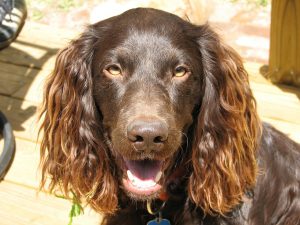A gundog, by nature, is at higher risk of eye and ear injury due to their active lifestyles. However, active dogs are also incredibly resilient and often mask injuries that could turn more serious if left untreated.
So, what signs should you look out for after a day out in nature?
Squinting – If your dog is squinting and has tears coming from an eye, they may have scratched their cornea. If the eye surface has been damaged, you could also see the third eyelid coming over across the eye.
Saline eye drops can help to reduce irritation but if problems persist you must visit the vet. If the injured eye has a smaller pupil it could be a sign of uveitis and can lead to long-term damage if not seen to.
Swollen eyes with discharge – Running through long grass with dust or pollen can cause conjunctivitis which shows as red, swollen eyes and sometimes with a green discharge.
If the dog is rubbing its eyes, it’s time to step in. Cold black tea or saline drops can help to give the eyes temporary relief, but if the eyes are still producing discharge the following day, it’s best to see your vet.
Cloudy eyes – Cloudy eyes are common in dogs of an older age, but if your dog’s eyes are rapidly whitening it could be due to cataracts and a vet should be contacted immediately.
Surgery can help to recover eyesight from cataracts.
Bulging eyes – Red, bulging eyes are often severely painful for your dog. This can be either one eye or both and can be brought on by infection or a tumour behind the eye.
Glaucoma is another factor which could be either due to damage or an inherited disease in some breeds. Either way, you must seek medical attention as an emergency.
Lots of head shaking – Ears can easily catch grass seeds that can get trapped into the ear canal, causing pain and lots of head shaking in an attempt to free them.
Sometimes the seeds dislodge themselves but if the head shaking continues, then a trip to the vet is usually required for removal. Remember to never poke anything into your dog’s ear.
Bleeding from cuts on ears – Ear cuts seem to bleed more than other areas. The best thing to do is apply pressure and a head bandage, to prevent further bleeding or irritation.
If bleeding persists, it’s time to go to the vet.
If you’re worried about your dog’s health, always seek professional advice from your vet by calling your local surgery. For information on First Aid in the Field.



